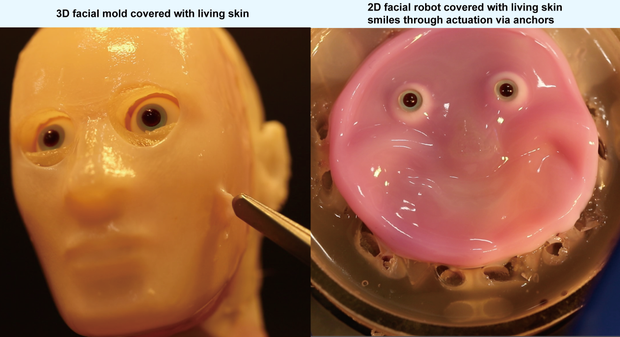/ CBS News
Farmers consider robots to aid labor shortage
A pink blob with beady eyes is gaining widespread attention online – because this newly-developed robot has what researchers call "living skin."
Professor Shoji Takeuchi of the University of Tokyo developed the alien-like machine using engineered skin attached to a humanoid robot.
Takeuchi previously created walking mini robots using 3D-printed lab-grown meat, engineered skin and biological muscle tissue. He decided to continue to develop the skin feature, which was grown in the Biohybrid Systems Laboratory at the university.

"During previous research on a finger-shaped robot covered in engineered skin tissue we grew in our lab, I felt the need for better adhesion between the robotic features and the subcutaneous structure of the skin," Takeuchi said in a news release. "By mimicking human skin-ligament structures and by using specially made V-shaped perforations in solid materials, we found a way to bind skin to complex structures."
He said the natural flexibility of the skin and its strong adhesion to the robot make it so that the skin can move without peeling or tearing. The researchers used collagen for adhesion and plasma treatment to move the collage into the perforations of the robots' mechanics. With this method, the skin can be added to any surface.
But, he said, this method is much harder than people might think because bacteria can enter the skin and the tissue can die.
Unlike chemical-based materials used to make skin, the living skin can self-heal, which Takeuchi said was a big deal.

The pink blob was just the 2D model of the living skin robot. The researchers also made a 3D model with a more human-like head shape. Takeuchi said the next challenge is making the skin thicker and adding features like wrinkles to make it more human-like.
"We believe that creating a thicker and more realistic skin can be achieved by incorporating sweat glands, sebaceous glands, pores, blood vessels, fat and nerves," he said in the news release. "Of course, movement is also a crucial factor, not just the material, so another important challenge is creating humanlike expressions by integrating sophisticated actuators, or muscles, inside the robot."
"Creating robots that can heal themselves, sense their environment more accurately and perform tasks with humanlike dexterity is incredibly motivating," he said.
So, what might these human-like living skin robots be used for? Takeuchi says these robots can be used in medical research like drug development and can also be used in skin aging, cosmetics research and plastic surgeon training.
- In:
- Technology
- Robot
- Science
- Japan
Caitlin O'Kane is a New York City journalist who works on the CBS News social media team as a senior manager of content and production. She writes about a variety of topics and produces "The Uplift," CBS News' streaming show that focuses on good news.
